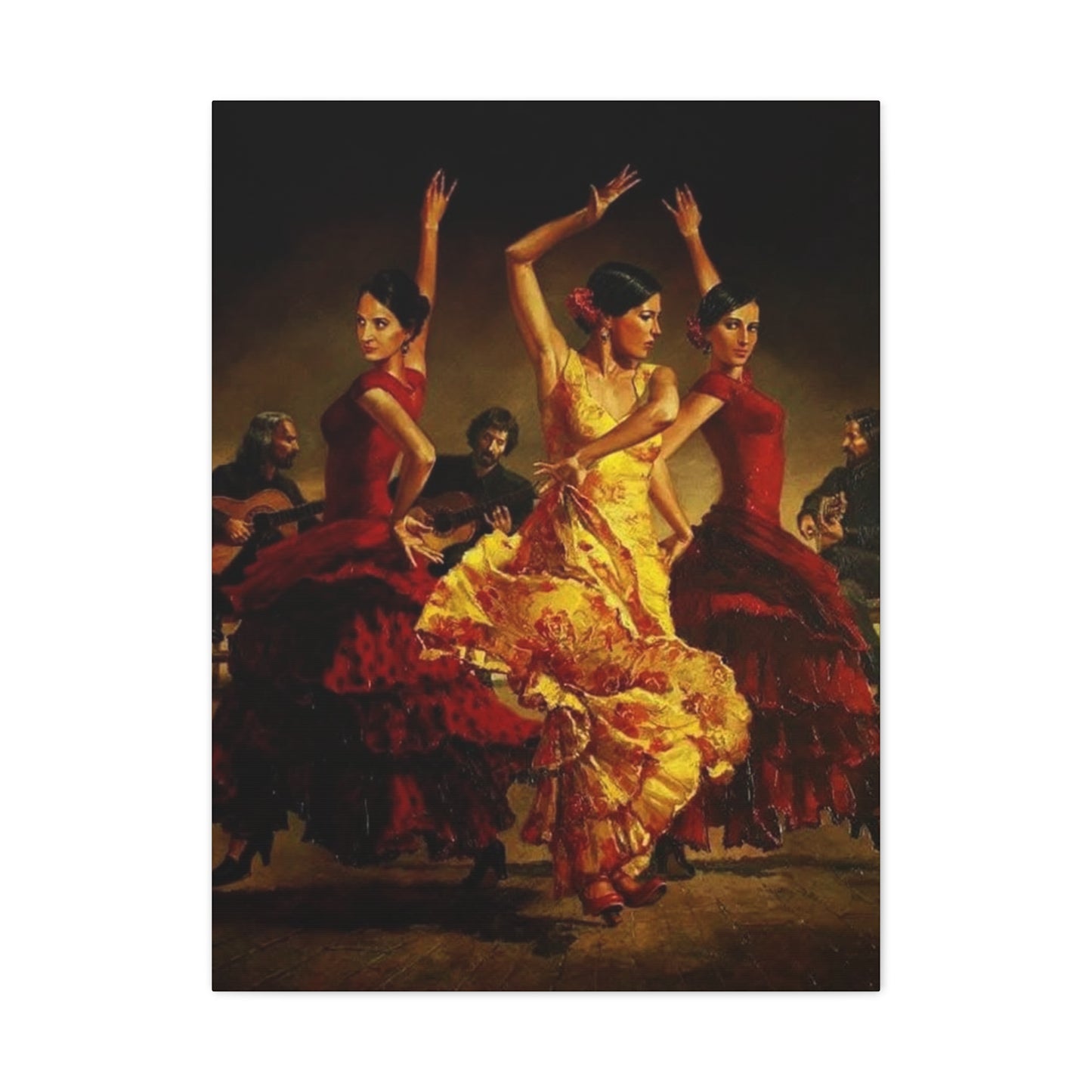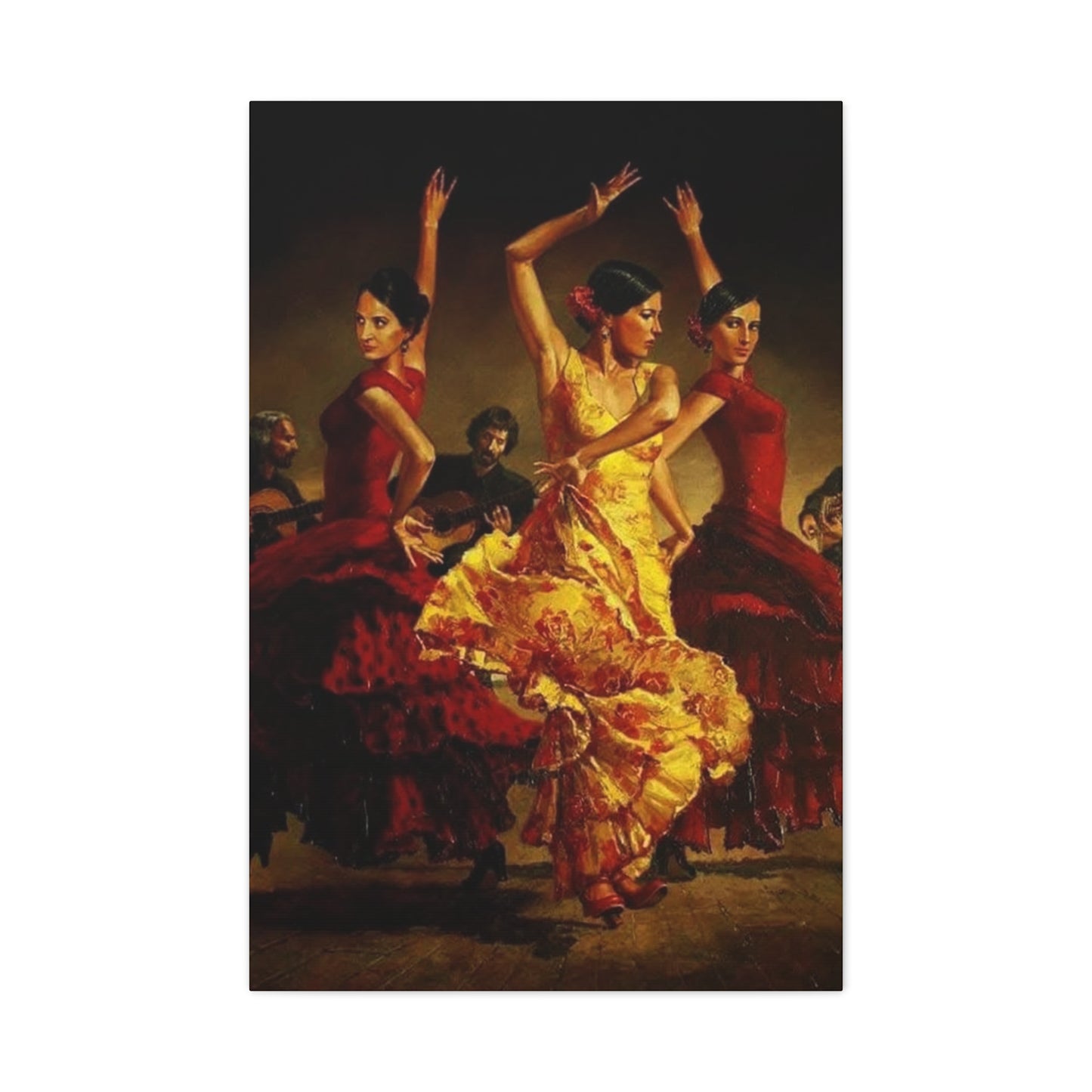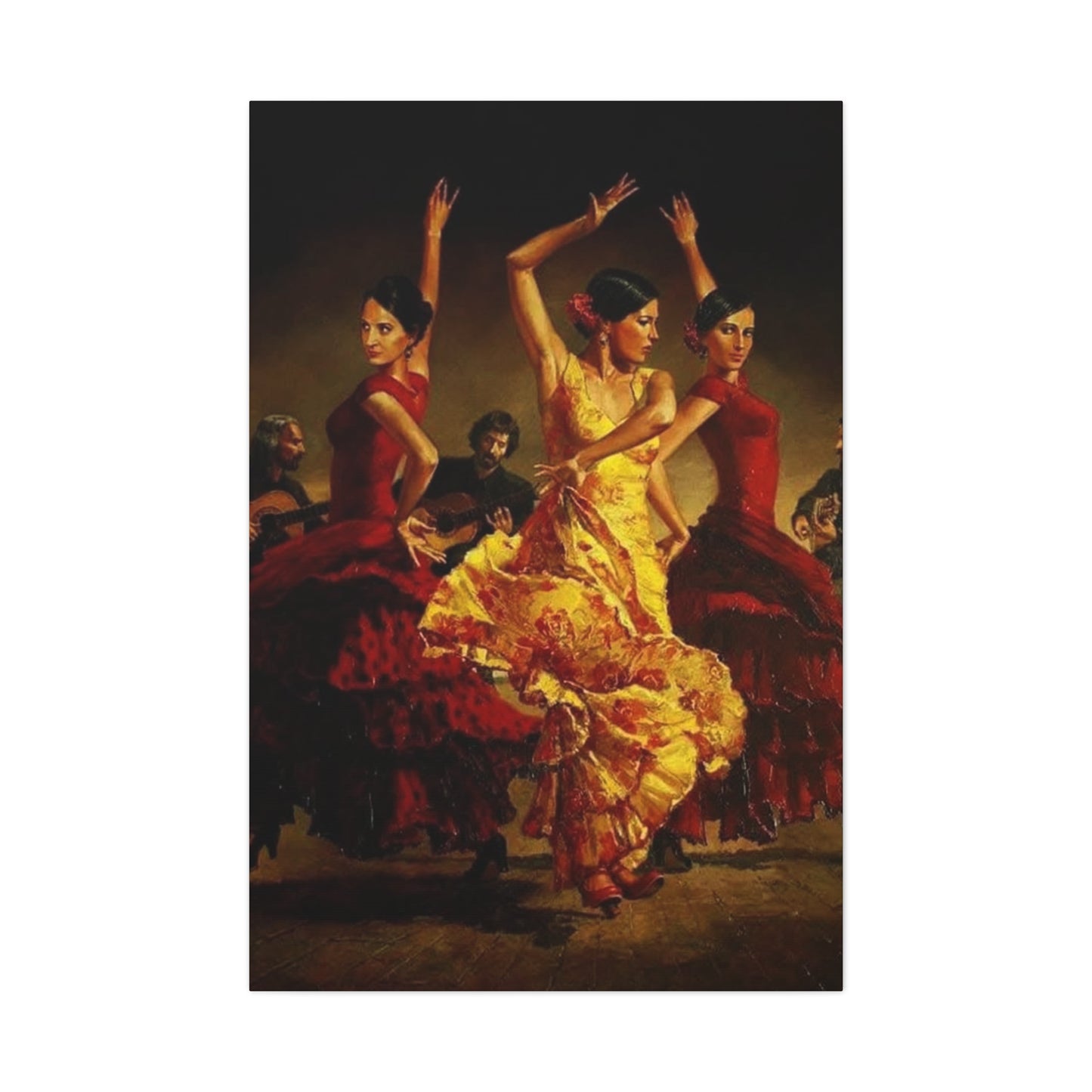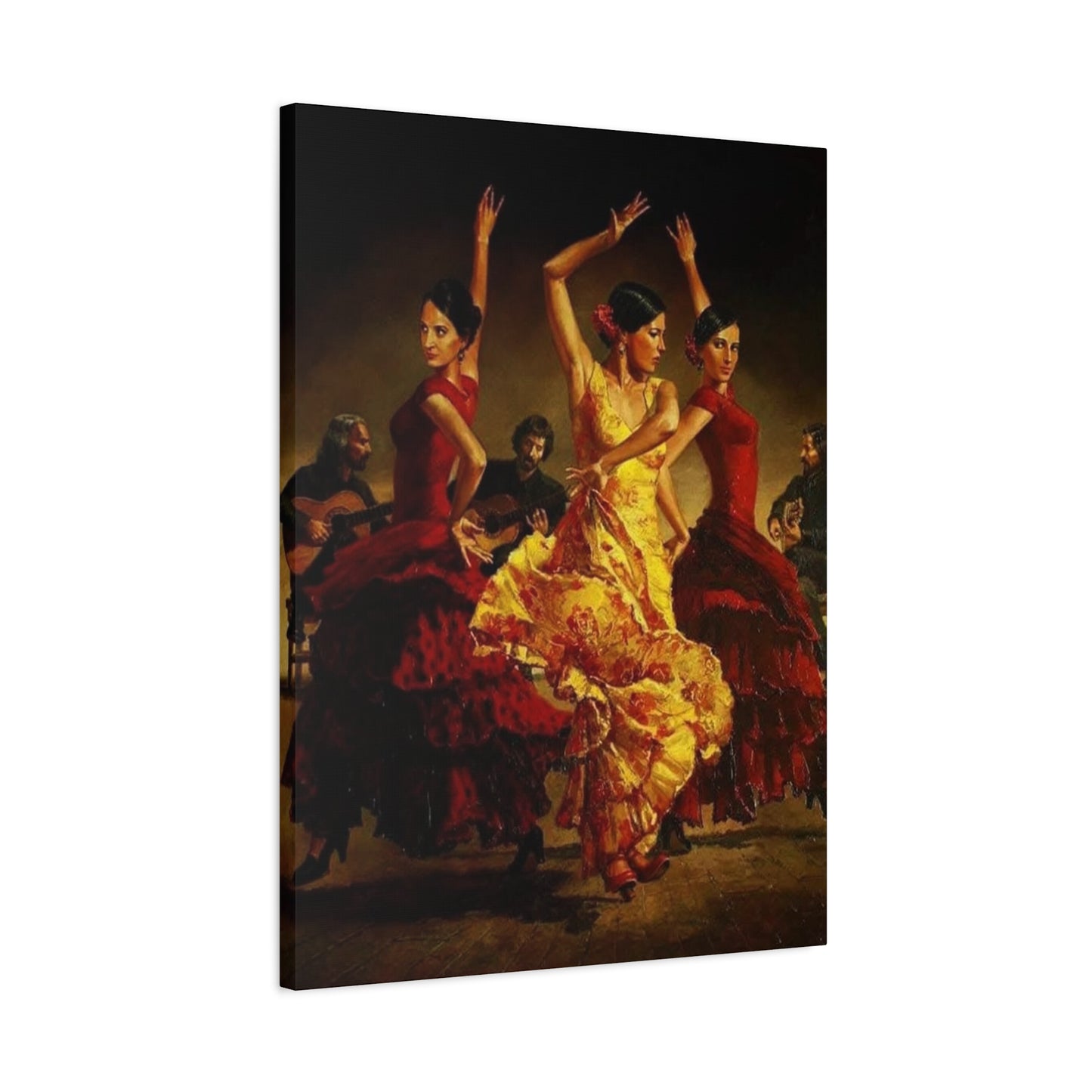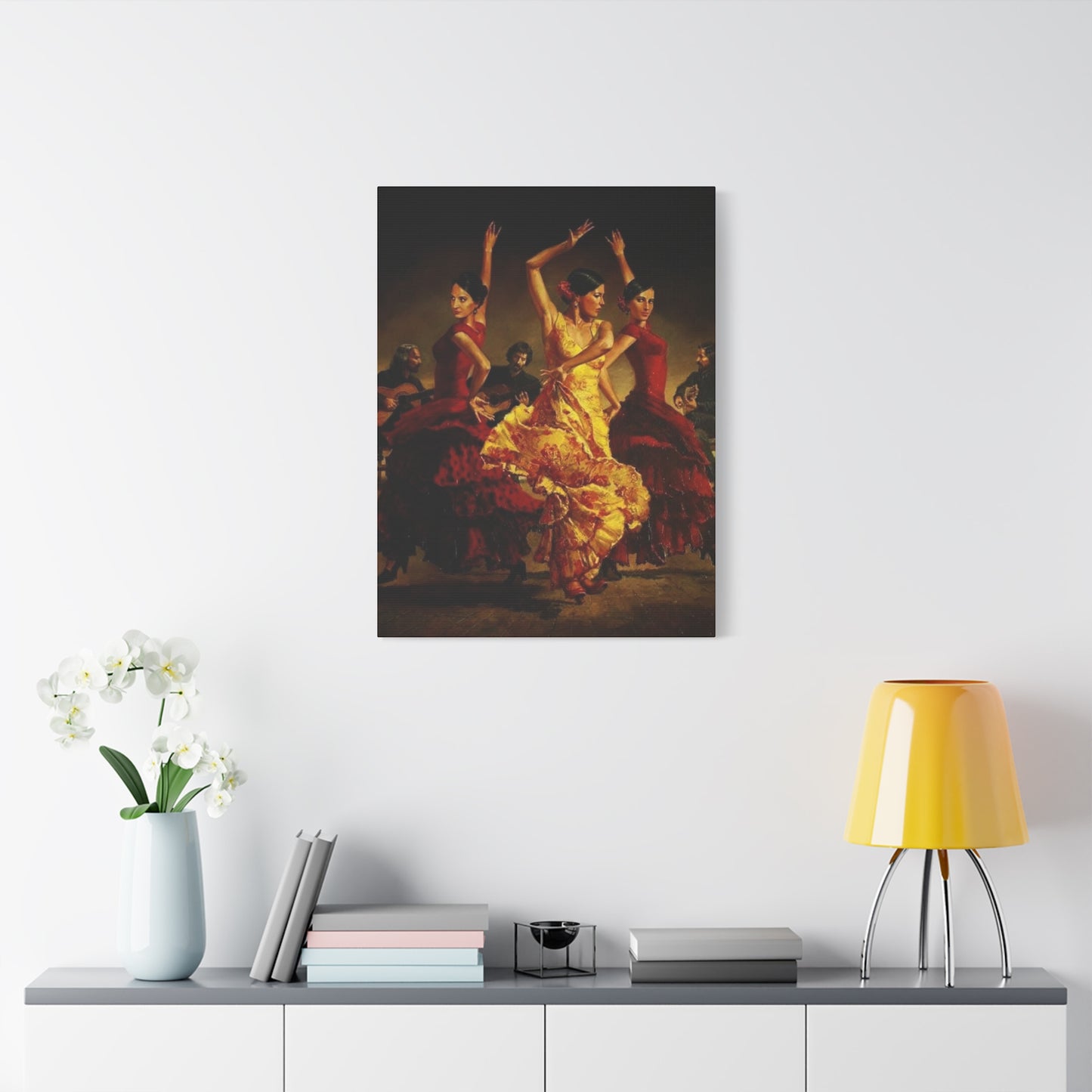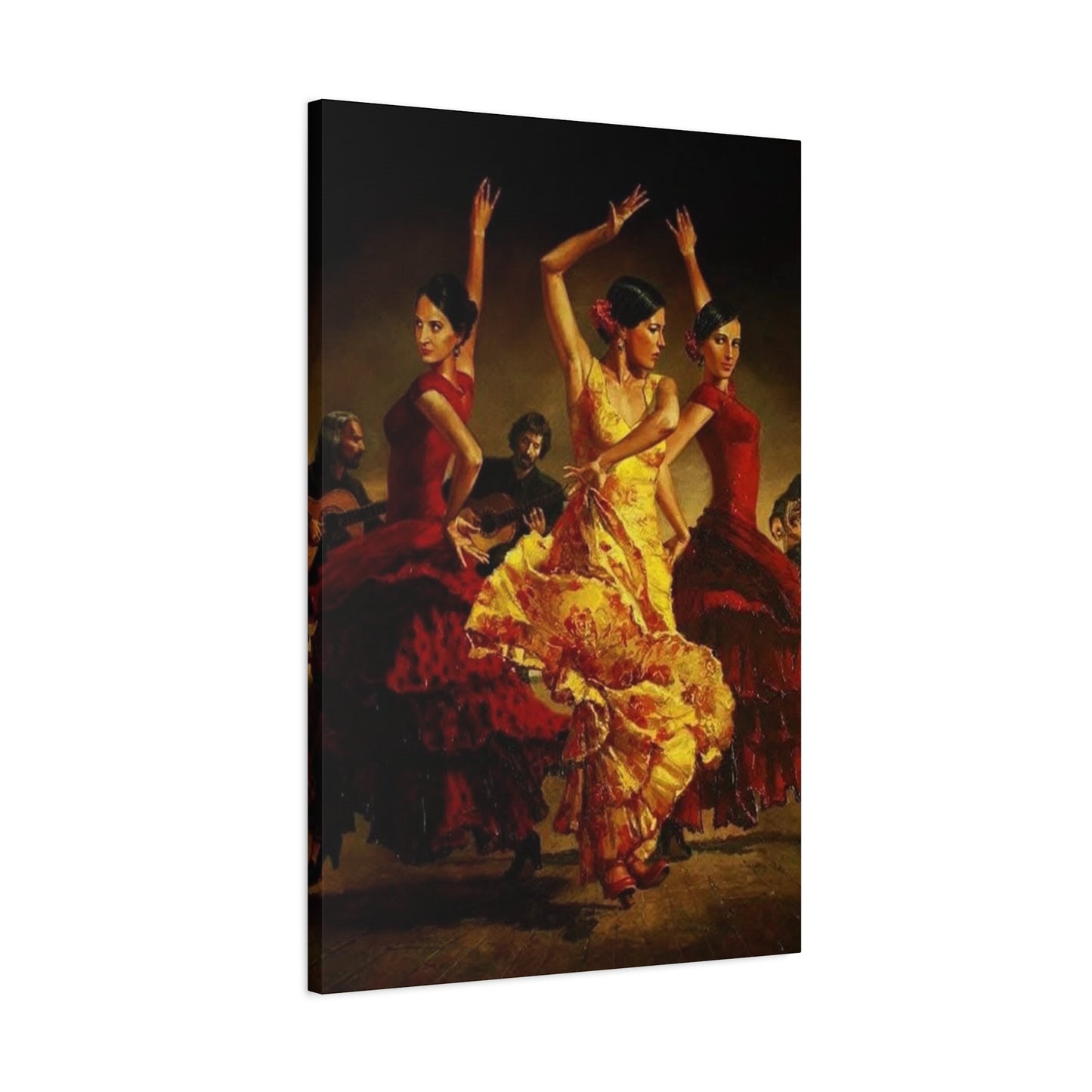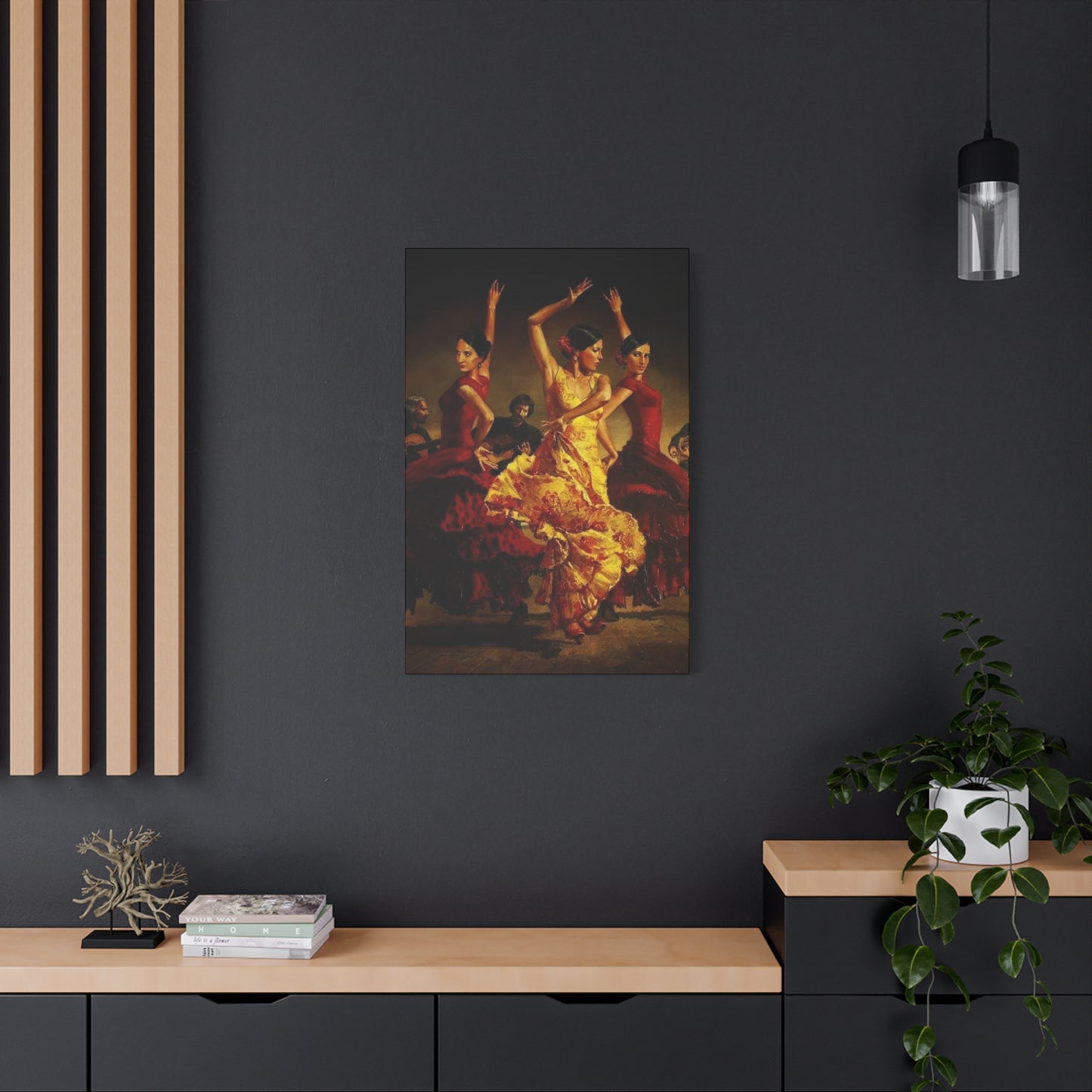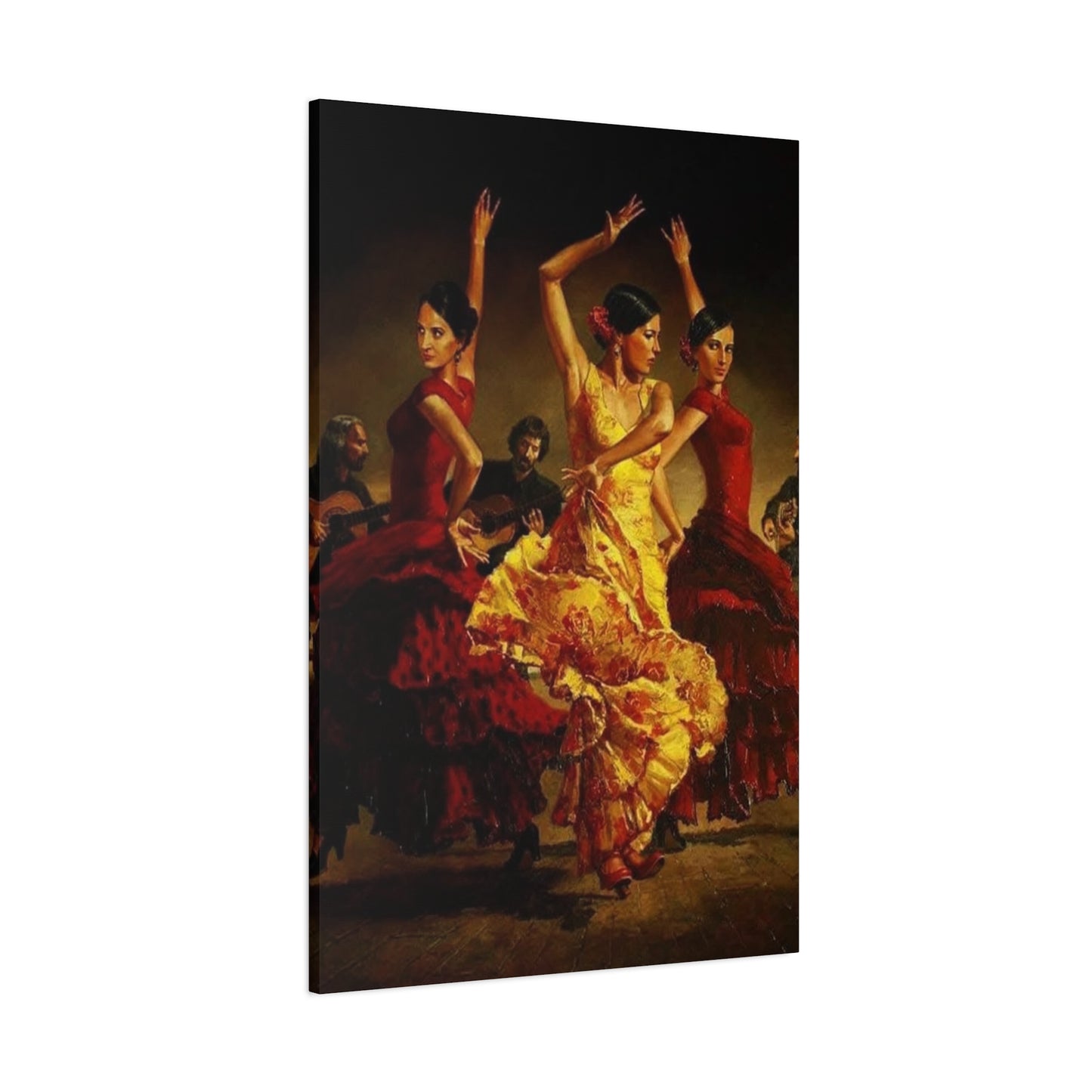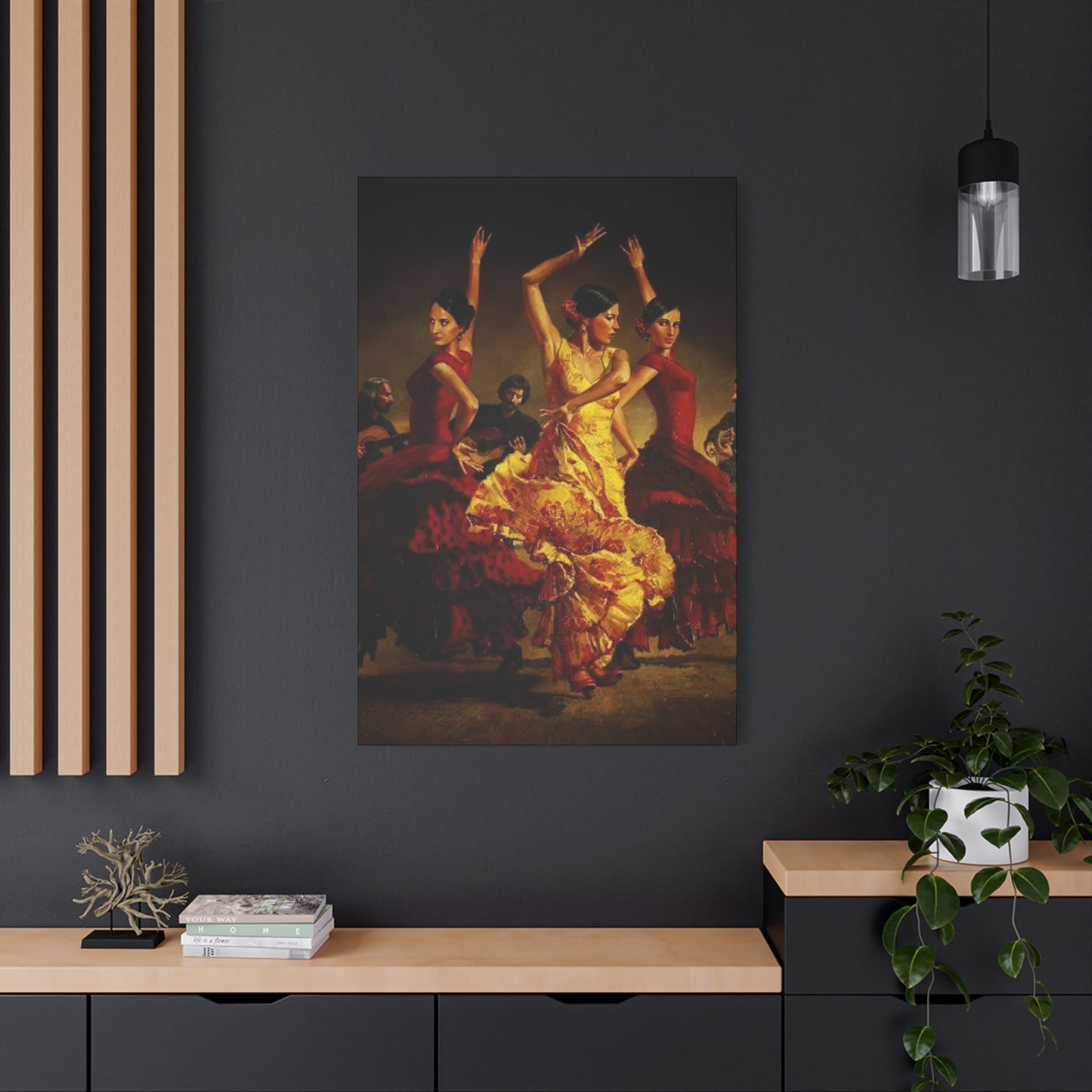Celebrating Spanish Heritage: The Beauty of Traditional Dancer Group Wall Art
The rich cultural heritage of Spain comes alive through the passionate movements and vibrant colors of traditional dance forms, particularly flamenco. When you bring these dynamic artistic expressions into your home or workspace through carefully selected wall decorations, you create an atmosphere that celebrates one of the world's most captivating cultural traditions. The visual representation of dancers in motion, adorned in their distinctive attire, offers more than mere decoration—it transforms ordinary walls into statements of cultural appreciation and artistic sophistication.
The journey of incorporating Spanish dance imagery into interior design begins with understanding the profound cultural significance behind these art forms. Flamenco, originating from the Andalusian region, represents centuries of cultural fusion, combining Romani, Moorish, and Spanish influences into a passionate artistic expression. When you select artwork featuring these dancers, you're not simply choosing decoration; you're inviting the spirit of Spanish culture into your living environment. The dramatic poses, flowing fabrics, and intense emotions captured in these artistic representations create focal points that draw the eye and spark conversation.
Contemporary interior design increasingly embraces cultural elements that add depth and character to spaces. The incorporation of dance-themed artwork serves multiple purposes: it provides visual interest, introduces cultural education opportunities, and creates emotional connections within the space. Whether displayed in residential settings, dance studios, cultural centers, or commercial establishments, these artistic pieces communicate passion, tradition, and artistic excellence.
The selection process for dance-themed wall decorations involves considering various factors including color schemes, artistic styles, size proportions, and the overall ambiance you wish to create. From bold, colorful representations that command attention to subtle, elegant silhouettes that suggest movement through minimalist design, the options span a wide spectrum of artistic interpretations. Understanding these variations helps you make informed decisions that align with your aesthetic preferences and spatial requirements.
Spain Dancer Wall Art Ideas
Creating stunning visual displays featuring Spanish dancers requires thoughtful consideration of artistic styles, placement strategies, and thematic coherence. The world of dance-inspired wall decorations offers endless possibilities for personalizing your space with culturally rich imagery. When exploring ideas for incorporating these artistic elements, consider how different interpretations of dance can complement various interior design schemes while maintaining the authentic spirit of Spanish cultural traditions.
Traditional representations often feature dancers captured mid-performance, with skirts swirling in circular patterns that seem to defy gravity. These dynamic compositions work exceptionally well in spaces where you want to create energy and movement. The visual flow created by the fabric's motion guides the viewer's eye across the artwork, creating a sense of rhythm that mirrors the actual dance performance. Such pieces typically incorporate rich color palettes dominated by deep reds, blacks, and golds—colors traditionally associated with flamenco performances.
Contemporary interpretations offer fresh perspectives on traditional themes, sometimes abstracting the dancer's form into geometric patterns or focusing on specific elements like the intricate footwork or dramatic hand positions that characterize Spanish dance. These modern approaches appeal to those seeking to balance cultural appreciation with contemporary design sensibilities. Abstract representations might emphasize color and movement over literal depiction, creating pieces that suggest the essence of dance rather than documenting it photographically.
Mixed media approaches combine various artistic techniques to create layered, textured pieces that add dimensional interest to walls. These might incorporate actual fabric elements, metallic accents, or three-dimensional components that extend beyond the flat picture plane. Such pieces create shadow patterns that change throughout the day as natural light shifts, adding an ever-evolving quality to the artwork. The tactile nature of these pieces invites closer inspection and creates more intimate viewer engagement.
Photographic interpretations capture actual performances, preserving authentic moments of cultural expression. High-quality performance photography freezes split-second moments that would be impossible to appreciate during live performances, revealing the athleticism, precision, and artistry involved in traditional Spanish dance. These pieces often work exceptionally well in educational settings or spaces dedicated to dance instruction, where they serve both decorative and inspirational purposes.
Vintage-inspired designs evoke nostalgia for earlier eras of Spanish cultural expression, often featuring stylized representations reminiscent of early twentieth-century poster art. These pieces incorporate typography, border designs, and color treatments that reference historical advertising and promotional materials for dance performances. Such artwork appeals to those who appreciate retro aesthetics while celebrating cultural traditions.
The scale of dance-themed artwork significantly impacts its effectiveness in a space. Oversized statement pieces create dramatic focal points that immediately draw attention and establish the room's character. These large-scale works often feature multiple dancers or capture a single dancer in such detail that viewers feel transported into the performance space. Conversely, smaller pieces work beautifully when arranged in gallery walls or grouped in triptychs that tell visual stories across multiple panels.
Color treatment in dance artwork ranges from vibrant, saturated hues that celebrate the costume traditions of performance to monochromatic schemes that emphasize form and movement over decorative detail. Black and white interpretations offer timeless elegance, focusing viewer attention on the dancer's posture, gesture, and expression without the distraction of color. These pieces integrate seamlessly into minimalist or monochromatic interior design schemes while still providing the cultural richness of the subject matter.
Seasonal and festival-specific imagery captures dancers during particular celebrations, incorporating props, settings, and costume variations associated with specific events in the Spanish cultural calendar. These specialized pieces appeal to those with specific cultural connections or interests in particular regional traditions within Spain's diverse dance heritage.
The framing and presentation of dance artwork contributes significantly to its overall impact. Traditional ornate frames complement classic representations, while sleek modern frames or frameless presentations suit contemporary interpretations. Some pieces benefit from matting that creates visual breathing space around the image, while others gain impact from edge-to-edge presentation that maximizes the image's presence.
Lighting considerations enhance dance artwork's effectiveness, with directed spotlighting creating drama and emphasis, while ambient lighting allows pieces to integrate more subtly into the overall room design. Some collectors install specialized art lighting that can be adjusted to change the mood and prominence of pieces depending on the time of day or occasion.
Flamenco Dance Posters for Home
Bringing the passionate energy of flamenco into residential spaces through carefully selected posters offers an accessible and flexible approach to cultural decoration. The poster format provides advantages in terms of affordability, variety, and ease of updating as tastes evolve or spaces are redesigned. Quality flamenco posters capture the essential elements of this iconic dance form—the dramatic poses, expressive faces, and flowing costumes—while offering practical solutions for renters or those who prefer to refresh their decor periodically.
The history of flamenco posters extends back to the late nineteenth and early twentieth centuries when lithographic printing techniques allowed for mass production of colorful promotional materials for performances. These vintage designs, now often reproduced, feature distinctive artistic styles characteristic of their eras, including Art Nouveau flourishes, Art Deco geometry, and mid-century modern simplification. Collectors and design enthusiasts prize these historical reproductions for their cultural authenticity and nostalgic appeal.
Modern flamenco poster designs embrace contemporary graphic design principles while respecting the traditional subject matter. Digital illustration techniques allow artists to create bold, stylized representations that work particularly well in modern interior settings. Vector-based designs featuring clean lines and simplified forms translate traditional flamenco imagery into contemporary visual language that appeals to younger audiences while maintaining cultural authenticity.
Typography plays a significant role in many flamenco poster designs, particularly those referencing promotional materials for actual or imagined performances. The integration of Spanish language text, venue information, and decorative lettering adds layers of visual interest and cultural specificity. Even when the text is purely decorative rather than informative, it contributes to the authentic atmosphere of the piece.
Color psychology considerations influence how flamenco posters affect the mood of a space. Traditional color palettes dominated by reds, blacks, and golds create warmth and drama, making them particularly effective in social spaces like dining rooms or entertainment areas. These passionate colors stimulate conversation and create energy that enhances social gatherings. Alternatively, cooler color interpretations featuring blues, purples, or monochromatic schemes offer the cultural richness of flamenco imagery while creating calmer, more contemplative atmospheres suitable for bedrooms or study areas.
The paper quality and printing techniques used for flamenco posters significantly impact their visual appeal and longevity. Museum-quality giclée prints on archival paper ensure color accuracy and durability, making them worthy of prominent display in main living areas. These high-quality reproductions rival original artwork in visual impact while remaining more accessible in terms of cost. Standard poster printing on commercial paper stock serves well for temporary displays or high-turnover environments where affordability outweighs archival concerns.
Size selection for flamenco posters requires considering both the wall space available and the desired impact. Standard poster sizes ranging from small accent pieces to large statement prints offer options for various applications. Multiple smaller posters arranged in deliberate configurations create dynamic gallery walls that tell visual stories or explore thematic variations. Single large-format posters serve as standalone focal points that anchor a room's design scheme.
Framing options for flamenco posters range from simple clip frames that emphasize the poster's graphic qualities to elaborate custom framing that elevates the piece to fine art status. The choice depends on budget, the poster's quality and significance, and the overall design aesthetic of the space. Professional framing with archival matting and UV-protective glazing preserves valuable or meaningful posters while enhancing their presentation.
Poster placement strategies maximize visual impact while respecting the flow and function of living spaces. Above seating areas, posters create visual interest for seated occupants and establish conversation-starting focal points. In hallways and transitional spaces, posters guide movement through the home while making efficient use of otherwise underutilized wall space. Bedroom placement allows for personal expression in private spaces where cultural interests and passions can be displayed without consideration for broader household aesthetic consensus.
Thematic poster collections allow enthusiasts to explore different aspects of flamenco culture through multiple pieces. A collection might focus on different regional styles, various historical periods, diverse artistic interpretations, or the work of particular poster artists or photographers. Building collections over time creates opportunities for ongoing engagement with the art form and provides flexibility to rotate displayed pieces, keeping the home environment fresh and engaging.
Educational aspects of flamenco posters add depth beyond mere decoration. Pieces that include informational text about dance styles, cultural context, or historical background serve double duty as both art and learning tools. This quality makes them particularly appropriate for family homes where children benefit from exposure to diverse cultural traditions, or in educational settings where they complement curriculum objectives.
The versatility of poster format allows for creative display solutions beyond traditional framing. Magnetic hanging systems, decorative clips, or poster rails offer alternative mounting methods that suit casual or frequently updated display strategies. Some enthusiasts create rotating poster displays that change with seasons, holidays, or simply when they desire a fresh visual perspective.
Traditional Spanish Dance Murals
Large-scale wall murals featuring traditional Spanish dance scenes transform ordinary rooms into immersive cultural environments that celebrate one of Spain's most significant artistic traditions. Unlike smaller artwork pieces, murals create enveloping experiences that fundamentally alter the character and atmosphere of a space. The process of selecting, designing, and installing dance-themed murals requires careful planning but yields dramatic results that make powerful design statements while honoring cultural heritage.
The scope and scale of mural projects allow for unprecedented detail and complexity in depicting dance scenes. Full-wall murals might portray entire performance ensembles, complete with musicians, multiple dancers at various stages of choreography, and rich environmental details suggesting performance venues. This comprehensive approach immerses viewers in the full cultural context of Spanish dance traditions, creating educational opportunities alongside aesthetic pleasure.
Regional variation in Spanish dance traditions offers rich subject matter for mural designs. While flamenco dominates popular consciousness of Spanish dance, numerous regional folk traditions provide equally compelling visual material. Designs featuring Catalonian sardanas, Basque aurresku, Galician muiñeiras, or Aragonese jotas celebrate Spain's cultural diversity while offering visual alternatives to more common flamenco imagery. These regional styles feature distinctive costumes, instrumental accompaniments, and movement vocabularies that translate into unique visual compositions.
Historical narrative murals tell stories through sequential images showing the evolution of Spanish dance traditions, the progression of a particular performance, or moments from famous historical performances. This storytelling approach adds intellectual engagement to the aesthetic experience, encouraging viewers to spend time with the mural, discovering new details and understanding connections between different elements of the composition.
Abstract interpretations of traditional dance translate the essential qualities of movement, rhythm, and cultural expression into non-representational visual forms. These murals capture the spirit and energy of dance without literal depiction, using color, line, shape, and composition to evoke the emotional and kinetic qualities of performance. Such approaches suit contemporary design sensibilities while maintaining connections to cultural traditions through title, color palette, or compositional rhythms that reference dance structures.
Custom mural commissions allow for personalized designs that reflect specific interests, family heritage, or design requirements. Working with mural artists to develop original compositions ensures that the final artwork perfectly suits the space and fulfills the client's vision. This collaborative process might incorporate family photographs, specific regional references, or design elements that coordinate with existing furnishings and architectural features.
The technical execution of dance murals varies according to application method and desired aesthetic. Hand-painted murals by skilled artists offer unique, one-of-a-kind creations with visible brush strokes and artistic interpretation. These traditional techniques create artwork with inherent value and character that mass-produced options cannot replicate. Alternatively, digitally printed murals allow for photographic accuracy and detailed reproduction of existing artworks or photographs, offering different aesthetic qualities and typically lower costs.
Removable mural wallpaper provides flexibility for renters or those who anticipate future design changes. These peel-and-stick products feature dance imagery printed on specialized materials that adhere to walls without permanent adhesive, allowing for installation and removal without wall damage. This innovation makes mural-scale artwork accessible to broader audiences while accommodating changing tastes and living situations.
Partial wall murals and accent walls balance dramatic visual impact with design restraint, incorporating mural artwork on a single wall or section while leaving other walls in complementary solid colors. This approach allows the mural to serve as a clear focal point without overwhelming the space, creating visual hierarchy and maintaining some design simplicity that prevents sensory overload.
Color coordination between murals and existing room elements requires careful consideration during the design phase. Professional designers often pull accent colors from the mural to inform choices for furnishings, textiles, and decorative accessories, creating cohesive design schemes where the mural integrates harmoniously rather than clashing with surrounding elements. This coordination might mean selecting mural designs with specific color palettes or working with artists to adjust colors in custom commissions.
Lighting design significantly impacts how murals are experienced. Natural light interacting with mural surfaces changes throughout the day, revealing different details and creating varying moods from morning through evening. Artificial lighting installations might include adjustable fixtures that allow homeowners to emphasize different mural sections or create dramatic effects for entertaining. Some installations incorporate subtle backlighting or projection effects that add dynamic elements to static imagery.
The architectural integration of murals considers existing room features like windows, doors, built-in shelving, and architectural details. Skilled designers work with these elements rather than against them, sometimes incorporating them into the mural composition or using them as natural borders and framing devices. This integration creates seamless relationships between architecture and artwork that enhance both elements.
Maintenance and preservation of dance murals depends on the materials and techniques used in their creation. Hand-painted murals might benefit from periodic professional cleaning and possible touch-up work over years of display. Digitally printed murals typically prove more durable and easier to maintain, often requiring only gentle cleaning with appropriate products. Understanding care requirements ensures that murals maintain their visual impact throughout their intended lifespan.
The psychological impact of immersive mural environments should not be underestimated. Large-scale cultural imagery creates strong sense of place and can influence mood and behavior within the space. Dance murals tend to create energetic, positive atmospheres that encourage social interaction and cultural curiosity, making them particularly effective in family gathering spaces, cultural centers, or hospitality environments.
Group Dancer Canvas Prints
The visual dynamics of multiple dancers depicted together on canvas creates compelling artwork that captures the collaborative nature of traditional Spanish dance forms. Group dancer compositions offer richer narrative possibilities than solo dancer images, suggesting the social and communal dimensions of dance culture while creating more complex and engaging visual arrangements. The canvas medium provides texture and dimensionality that enhance the tactile and visual qualities of these important cultural images.
Choreographic patterns formed by multiple dancers create natural compositional structures that artists and photographers exploit for visual interest. The geometric arrangements of group formations—lines, circles, clusters—provide structural frameworks that guide viewer attention through the composition. These patterns mirror the actual spatial organization of traditional dances, where formations carry cultural significance and aesthetic purpose. Capturing these arrangements in canvas prints preserves both the visual beauty and cultural authenticity of the dance traditions.
The canvas texture itself contributes to the artwork's character, with the subtle weave pattern adding organic quality that complements the human subject matter. Gallery-wrapped canvases where the image continues around the edges eliminate the need for framing, creating contemporary presentations that suit modern interiors while reducing display costs. The three-dimensional quality of stretched canvas creates subtle shadow lines where the canvas meets the wall, adding architectural interest that flat prints cannot achieve.
Individual characterization within group compositions allows viewers to engage with multiple dancers simultaneously, discovering different expressions, postures, and details with repeated viewing. This complexity creates artwork with lasting interest that rewards sustained attention. Some compositions feature dancers at different moments in the same choreographic sequence, creating narrative progression within a single frame that suggests movement and temporal flow.
The coordination of costumes across group dancer images provides opportunities for visual harmony or deliberate contrast. Matching traditional dress creates unified visual impact emphasizing the group over individuals, appropriate for representing formal performance ensembles or traditional celebrations. Alternatively, variations in costume color, style, or elaboration introduce visual variety while suggesting different roles, personalities, or regional traditions within the broader cultural context.
Scale relationships between the canvas size and the depicted dancers influence the intimacy or grandeur of the viewing experience. Life-size or larger-than-life representations create powerful presence and immediacy, positioning viewers as virtual audience members to the performance. Smaller-scale presentations offer different qualities, perhaps suggesting cherished memories of performances attended or creating jewel-like images that reward close inspection.
Series of related canvas prints depicting progressive moments in a dance performance create kinetic sequences when displayed together. This cinematic approach to still imagery suggests motion through sequential viewing, with the viewer's eye traveling from panel to panel following the choreographic development. Such series work particularly effectively in long hallway spaces or above extended furniture pieces where the horizontal arrangement naturally supports sequential viewing.
The interplay between positive and negative space in group compositions creates rhythm and breathing room that prevents visual overcrowding. Skilled compositions balance the active areas where dancers occupy space with quieter zones that allow visual rest and emphasize the energy of the performed areas. This compositional breathing mirrors the actual dynamic variation in dance performances, where moments of intense activity alternate with pauses and transitions.
Color relationships within and between group dancer canvases significantly impact their effectiveness in interior settings. Monochromatic schemes create sophisticated, cohesive presentations that integrate easily into diverse design schemes. Limited color palettes featuring two or three dominant hues create visual unity while avoiding monotony. Full-color treatments celebrate the vibrant costume traditions and energetic atmosphere of traditional performances, creating artwork that commands attention and creates focal points within rooms.
The perspective from which group dancers are depicted affects the viewer's relationship to the artwork. Front-facing compositions position viewers as audience members, creating psychological distance appropriate for appreciating formal performances. Aerial or elevated viewpoints reveal choreographic patterns more clearly, emphasizing the geometric beauty of group formations. Close, intimate perspectives draw viewers into the group, creating psychological participation in the dance rather than observation from distance.
Background treatment in group dancer canvases ranges from detailed environmental depiction to complete abstraction. Detailed backgrounds situating dancers in specific venues or landscapes provide cultural and historical context that educates while decorating. Simplified or abstracted backgrounds focus attention on the dancers themselves, avoiding distraction and creating more versatile artwork that adapts to various interior settings without color or style conflicts.
The emotional range expressed across multiple dancers within a composition creates psychological depth and narrative possibility. Capturing varied expressions—concentration, joy, exhaustion, exhilaration—humanizes the dancers and reminds viewers of the emotional labor and physical demands of traditional dance. This emotional authenticity creates more meaningful artwork that engages viewers' empathy alongside their aesthetic appreciation.
Production quality in canvas printing technology has advanced significantly, allowing for remarkable color accuracy, detail resolution, and image stability. Professional printing services using archival inks and museum-quality canvases produce artwork suitable for long-term display without significant fading or degradation. Understanding these quality factors helps consumers make informed choices when investing in group dancer canvas artwork.
Installation strategies for canvas prints consider both aesthetic and practical concerns. Professional hanging systems ensure security while allowing for easy repositioning as design preferences evolve. Grouping multiple related canvases requires careful planning of spacing, alignment, and configuration to create cohesive visual statements rather than cluttered arrangements. Templates and measurement guides facilitate proper installation, ensuring professional results that honor the artwork and enhance the space.
Spain Wall Art for Living Rooms
The living room serves as the primary gathering and entertaining space in most homes, making artwork selection particularly important for establishing atmosphere and expressing cultural interests. Spanish dance-themed wall art brings cultural sophistication and visual energy to these social spaces, creating conversation-starting focal points while contributing to comfortable, welcoming environments. The selection process requires balancing aesthetic preferences with practical considerations including scale, color coordination, and thematic appropriateness.
The relationship between artwork and seating arrangements significantly impacts how art is experienced in living spaces. Pieces positioned above sofas or seating groups benefit from being sized appropriately to the furniture proportions—generally spanning two-thirds to three-quarters of the sofa width for proper visual balance. This scale relationship ensures the artwork appears intentional and integrated rather than awkwardly proportioned. Height placement typically positions the artwork's center at average standing eye level, though this guideline adjusts based on whether the art will primarily be viewed while seated or standing.
Color coordination between Spanish dance artwork and existing living room palettes requires strategic thinking about complementary and contrasting hues. Artwork might either harmonize with existing colors, creating cohesive, calming environments, or introduce dramatic contrast that generates visual excitement and defines distinct design zones. The warm reds, oranges, and golds common in flamenco imagery coordinate beautifully with earth-tone interiors while providing energy boosts to neutral color schemes. Conversely, selecting artwork with cooler palettes or black-and-white treatments allows for Spanish cultural themes while maintaining desired color restraint.
Lighting conditions in living rooms influence artwork selection and presentation. Natural light from windows creates changing conditions throughout the day, affecting how colors appear and how visible surface details remain. North-facing rooms with cooler, more constant light suit artwork with warmer color palettes that compensate for the cool ambient light. South-facing rooms with warm, bright light accommodate cooler-toned artwork or pieces protected from direct sun exposure to prevent fading. Artificial lighting supplements or replaces natural light during evening hours when living rooms often see peak use, making it important to evaluate artwork under various lighting conditions before final selection.
The style consistency between Spanish dance artwork and overall living room design aesthetics ensures visual harmony. Traditional interiors with classical furniture and formal arrangements complement traditional or vintage-style dance artwork featuring realistic representations and classical framing. Contemporary living spaces with modern furniture and minimalist approaches pair effectively with abstract or stylized interpretations of dance themes. Eclectic interiors mixing style periods and influences offer the most flexibility, accommodating diverse artistic approaches to Spanish dance subjects.
Personal and family connections to Spanish culture add meaningful dimensions to artwork selection. Pieces commemorating personal travel experiences, family heritage, or special cultural events carry significance beyond pure aesthetics, creating genuine emotional connections that enrich the living environment. These meaningful pieces become conversation catalysts, allowing hosts to share stories and cultural knowledge with guests.
The permanence of artwork installations influences selection decisions. Homeowners planning long-term residence might invest in higher-quality, more expensive pieces that will provide lasting satisfaction. Renters or those anticipating future moves might prefer more affordable or portable options that accommodate changing circumstances without significant financial or logistical challenges. Understanding your timeframe and commitment level guides appropriate investment decisions.
Traffic flow and viewing distances in living rooms affect how artwork reads visually. Pieces intended for viewing from across the room require bold colors, strong contrast, and clear compositions that register from distance. Artwork positioned where viewers will have close access benefits from fine detail and subtle qualities that reward careful examination. Considering these functional aspects ensures that artwork performs effectively within its specific spatial context.
The artwork's role in establishing room focal points or competing with existing focal points requires strategic thinking. In living rooms dominated by architectural features like fireplaces, large windows, or entertainment centers, artwork might play supporting roles that complement without competing. In rooms lacking strong architectural features, artwork assumes greater importance in creating visual interest and establishing where attention naturally focuses.
Seasonal flexibility allows for artwork rotation that keeps living spaces feeling fresh and responsive to changing contexts. Some enthusiasts maintain collections of Spanish dance artwork in different styles or color schemes, rotating pieces with seasons or simply when they desire visual change. This approach provides variety and sustained engagement with cultural themes while preventing visual stagnation.
Budget considerations for living room artwork span wide ranges from affordable prints to significant investments in original art. Establishing clear budgets before shopping prevents frustration and helps focus searches on appropriate price ranges. Remember that framing and installation costs add to artwork prices, so factor these expenses into overall budgets. Quality pieces at various price points exist for virtually any budget, making cultural decoration accessible regardless of financial resources.
Family dynamics and household composition influence artwork appropriateness. Homes with young children might prioritize durability and placement height that prevents accidental damage while still allowing children to enjoy and learn from the imagery. Multi-generational households might seek artwork that appeals across age groups, finding pieces with both sophisticated aesthetic qualities and accessible, engaging subject matter.
The educational value of Spanish dance artwork in living rooms creates opportunities for cultural learning within everyday domestic life. Particularly in households with children, regular exposure to cultural imagery sparks curiosity and questions that parents can address, fostering cultural awareness and appreciation. This informal educational function adds value beyond pure decoration.
Artwork as investment requires different evaluation criteria than artwork for pure aesthetic enjoyment. Pieces selected for potential financial appreciation should come with documentation of authenticity, artist reputation, and provenance. Understanding art market dynamics and seeking expert guidance helps those interested in building collections with investment potential alongside decorative value.
Vintage Flamenco Wall Decor
The aesthetic appeal of vintage flamenco imagery draws upon nostalgic design sensibilities while celebrating the rich historical traditions of Spanish dance culture. Vintage-inspired or authentically historical flamenco artwork brings distinctive character to interior spaces, offering alternatives to contemporary design approaches that dominate current markets. The distinctive visual qualities of vintage pieces—aged patinas, historical graphic styles, and period-specific color treatments—create unique atmospheric effects that connect present-day spaces with cultural history.
Authentic vintage flamenco posters and promotional materials from the early to mid-twentieth century have become collectible items valued for their artistic merit and cultural documentation. These original pieces, when available, command premium prices in art markets but offer genuine historical artifacts that link contemporary owners with the actual cultural moments they depict. Collectors prize these originals for their authenticity and the tangible historical connections they represent.
High-quality reproductions of vintage flamenco materials provide accessible alternatives to rare originals, allowing broader audiences to enjoy the aesthetic and cultural qualities of historical designs. Modern printing technology reproduces vintage pieces with remarkable fidelity, capturing subtle color variations, paper textures, and even artificial aging effects that enhance period authenticity. These reproductions serve decorative purposes effectively while remaining affordable and readily available.
The artistic styles characteristic of different historical periods offer diverse aesthetic options within the vintage category. Art Nouveau designs from the late nineteenth and early twentieth centuries feature flowing organic lines, elaborate decorative borders, and stylized natural motifs integrated with the dance imagery. Art Deco pieces from the 1920s and 1930s employ geometric patterns, streamlined forms, and bold color blocks that reflect that era's design revolution. Mid-century modern approaches from the 1950s and 1960s feature simplified forms, limited color palettes, and graphic clarity that align with contemporary minimalist sensibilities while maintaining period character.
Typography in vintage flamenco materials contributes significantly to their period charm and visual appeal. Hand-lettered titles, decorative fonts, and Spanish language text add layers of visual interest while providing historical and cultural context. Even when text elements serve purely decorative functions rather than conveying information, they enhance authenticity and period atmosphere.
The color palettes characteristic of vintage printing processes create distinctive aesthetic qualities that differentiate historical pieces from contemporary productions. Limited color lithography processes produced specific hue ranges and color relationships that contemporary designers sometimes replicate to achieve authentic vintage appearances. Faded or muted colors resulting from age or historical printing limitations create gentler visual impacts than saturated contemporary colors, suiting certain interior aesthetics particularly well.
Distressed and aged finishes applied to reproduction pieces enhance vintage authenticity by mimicking the effects of time on original materials. Techniques including sepia toning, artificial foxing (age spots), edge wear, and surface texture simulation create convincing aged appearances that appeal to those seeking genuine vintage aesthetics without the costs and fragility of actual antiques. Understanding these treatments helps consumers evaluate reproduction quality and authenticity.
Framing strategies for vintage flamenco decor balance protection and presentation considerations. Period-appropriate frames enhance authenticity while protecting valuable or delicate pieces. Antique frames sourced from appropriate eras add genuine historical elements to presentations, though quality antique frames may cost more than the artwork they display. Reproduction frames styled after historical designs offer appropriate aesthetic contexts at more accessible price points.
The cultural documentation value of vintage flamenco materials extends beyond pure decoration, preserving visual records of how dance traditions were promoted and perceived in different historical moments. These materials reveal changing aesthetic preferences, marketing strategies, and cultural attitudes across different periods, offering insights into both dance history and broader cultural history. This documentary quality adds intellectual interest to aesthetic appreciation.
Themed collections of vintage flamenco materials might focus on specific artists, historical periods, regional traditions, or promotional contexts. Building coherent collections creates opportunities for deeper engagement with cultural history while developing valuable assemblages that may appreciate financially over time. Collectors often experience satisfaction in the research, acquisition, and curation processes that extend beyond the mere possession of attractive objects.
Display strategies for vintage flamenco collections balance preservation with visibility, as valuable or fragile historical pieces require protection from direct sunlight, humidity, and physical damage. Climate-controlled environments with filtered lighting preserve materials while allowing enjoyment and sharing with others. Rotation strategies that periodically change displayed pieces while storing others protects against cumulative light damage while providing visual variety.
Integration of vintage flamenco decor within contemporary interiors creates appealing juxtapositions between old and new that prevent spaces from feeling overly themed or costume-like. Mixing vintage dance imagery with contemporary furnishings and modern amenities creates layered, interesting environments that feel collected and personal rather than decorator-contrived. This eclectic approach allows cultural expressions within broadly contemporary lifestyle contexts.
Authentication and provenance research becomes important when acquiring potentially valuable vintage flamenco materials. Understanding markers of authenticity—printing techniques, paper types, artist signatures, publisher marks—helps collectors make informed purchases and avoid fraudulent reproductions marketed as originals. Expert consultation or reputable dealer relationships provide security when investing in significant pieces.
The market for vintage flamenco decor has expanded as interest in cultural history and retro aesthetics has grown in contemporary design. Online marketplaces, auction houses, antique dealers, and specialized ephemera vendors all offer access to historical materials, though quality, authenticity, and pricing vary considerably. Developing knowledge and cultivating relationships with reputable sources ensures satisfying collecting experiences.
Preservation and conservation of valuable vintage pieces may require professional intervention to stabilize deteriorating materials, remove harmful substances, or repair damage. Conservation specialists can restore pieces to displayable conditions while respecting their historical integrity, though conservation work represents significant expense justified only for particularly valuable or meaningful items.
Spanish Dance Wall Stickers
Wall stickers and decals featuring Spanish dance imagery provide versatile, accessible decoration options that appeal particularly to renters, temporary residents, and those who value design flexibility. These removable adhesive decorations allow for significant visual impact without the permanence of paint or the expense of framed artwork. The contemporary development of high-quality vinyl stickers with superior adhesion and removal properties has elevated this category from novelty items to legitimate design elements worthy of consideration in sophisticated interiors.
The technical construction of quality wall stickers involves vinyl materials with specialized adhesive formulations that bond effectively to wall surfaces while remaining removable without damaging paint or leaving residue. This balance between adherence and removability represents significant technical achievement that makes stickers viable for various applications. Understanding material quality differences helps consumers select products that will perform satisfactorily throughout their intended use period.
Design variety within the Spanish dance sticker category ranges from simple silhouettes to complex, multi-color detailed scenes. Silhouette stickers offer elegant simplicity and maximum versatility, coordinating easily with diverse color schemes and design styles. These simplified forms emphasize posture and movement through outline alone, creating striking visual statements with minimal detail. More elaborate stickers featuring full-color representations and environmental details provide richer visual experiences but require more careful coordination with existing room elements.
Customization options available from specialized vendors allow for personalized sticker designs tailored to specific preferences and requirements. Custom sizing ensures perfect scale relationships with available wall space. Color customization coordinates stickers with existing room palettes. Design modifications adapt stock imagery to specific visions. These customization possibilities elevate stickers from generic decorations to personalized artistic expressions.
Application techniques significantly affect installation success and final appearance. Proper wall preparation including cleaning and drying ensures optimal adhesion. Using application tools like squeegees eliminates air bubbles and ensures smooth, professional-looking results. Following manufacturer-specific instructions regarding temperature and humidity conditions during application prevents installation problems. Taking time for careful, methodical application yields results that look intentional and polished rather than hasty and amateur.
Removal processes for quality wall stickers should proceed carefully to minimize any risk of wall damage. Heating stickers gently with hair dryers softens adhesive and facilitates easier, cleaner removal. Peeling slowly and steadily from corners prevents tearing. Removing any adhesive residue with appropriate cleaners restores walls to original conditions. Understanding proper removal techniques ensures that the promised damage-free removal becomes reality.
The scale possibilities with wall stickers range from small accent elements to room-dominating full-wall installations. Large-format stickers create dramatic focal points comparable to painted murals but with the advantage of removability. Multiple smaller stickers arranged in deliberate compositions create customizable gallery-wall effects. Scale selection depends on available wall space, desired visual impact, and the role the stickers will play within the overall room design.
Three-dimensional layered sticker designs create depth effects by separating different compositional elements on independent layers. A dancer might occupy the foreground layer, with musicians or architectural elements on middle layers, and decorative or environmental details on background layers. This dimensional separation creates visual interest and allows for creative arrangement possibilities where installers determine the specific spatial relationships between layers.
Textured stickers featuring raised surfaces or fabric-like finishes add tactile interest beyond purely visual effects. These specialty products create more substantial physical presence than flat stickers, producing shadow effects that change with lighting conditions throughout the day. The enhanced dimensionality makes them read as more substantial design elements approaching the presence of traditional artwork.
Glow-in-the-dark Spanish dance stickers offer playful functionality particularly appealing in children's spaces or entertainment rooms. These specialty stickers charge under normal lighting and emit gentle glows in darkness, creating magical nighttime effects. While perhaps less sophisticated than standard stickers, they demonstrate the creative possibilities within this decoration category.
Temporary event decoration represents another important application for Spanish dance wall stickers. Their easy installation and removal make them ideal for parties, cultural celebrations, educational events, or business functions requiring temporary cultural atmosphere. Using stickers for these temporary applications avoids the expense and permanence of traditional decoration while achieving significant visual impact.
Educational applications of dance-themed stickers in classrooms or children's spaces combine decoration with learning opportunities. Stickers might include text labels identifying dance styles, regions, or cultural contexts alongside visual imagery. This educational dimension adds value beyond pure aesthetics, making stickers serve multiple classroom functions.
Combination approaches mixing wall stickers with other decoration types create layered, complex design schemes. Stickers might augment painted murals, add details to gallery walls, or interact with furniture placement in creative ways. This integrative approach uses stickers as design elements within broader decorative strategies rather than standalone solutions.
Budget considerations make wall stickers particularly appealing for cost-conscious decorators seeking visual impact without significant financial investment. Even high-quality custom stickers typically cost considerably less than framed artwork or painted murals, making cultural decoration accessible to broader audiences. This affordability allows for experimentation and frequent updates as tastes evolve.
Conclusion
Celebrating Spanish heritage through traditional dancer group wall art offers a vibrant window into the rich cultural tapestry that defines Spain’s identity. This art form beautifully encapsulates the passion, history, and communal spirit inherent in traditional Spanish dance. By immortalizing the movements, costumes, and expressions of these dancers, the artwork becomes much more than a visual decoration—it serves as a cultural narrative that honors centuries of tradition and artistic expression.
The beauty of traditional dancer group wall art lies in its ability to capture the dynamic energy and emotion of the performance. Each figure in the artwork embodies the pride, rhythm, and grace that characterize Spanish dance forms such as Flamenco, Sevillanas, and Jota. The vivid colors, intricate costumes, and fluid movements portrayed in the art reflect the deep connection between the dancers and their cultural roots. Through this, viewers can feel the heartbeat of Spain’s heritage, transcending language and geography.
Moreover, this art form fosters a deeper understanding and appreciation of the communal aspect of Spanish dance. The group dynamic is central to many traditional dances, emphasizing unity, shared celebration, and collective storytelling. The wall art, therefore, does not simply depict individuals dancing; it conveys the spirit of togetherness and cultural pride that these performances inspire. It invites viewers into a shared experience that celebrates identity, resilience, and joy.
Displaying traditional dancer group wall art also serves as a bridge between past and present, preserving a cultural legacy that continues to thrive today. It reminds us of the importance of honoring traditions while embracing their evolution in contemporary contexts. This kind of artwork enriches living spaces with cultural significance and inspires continued engagement with heritage, encouraging both reflection and celebration.
In essence, traditional dancer group wall art is a powerful tribute to Spanish heritage. It transforms moments of dance into lasting visual stories that celebrate culture, community, and artistic beauty. By bringing these traditions to life on walls, this art nurtures pride, inspires connection, and keeps the vibrant spirit of Spanish dance alive for generations to come.

















